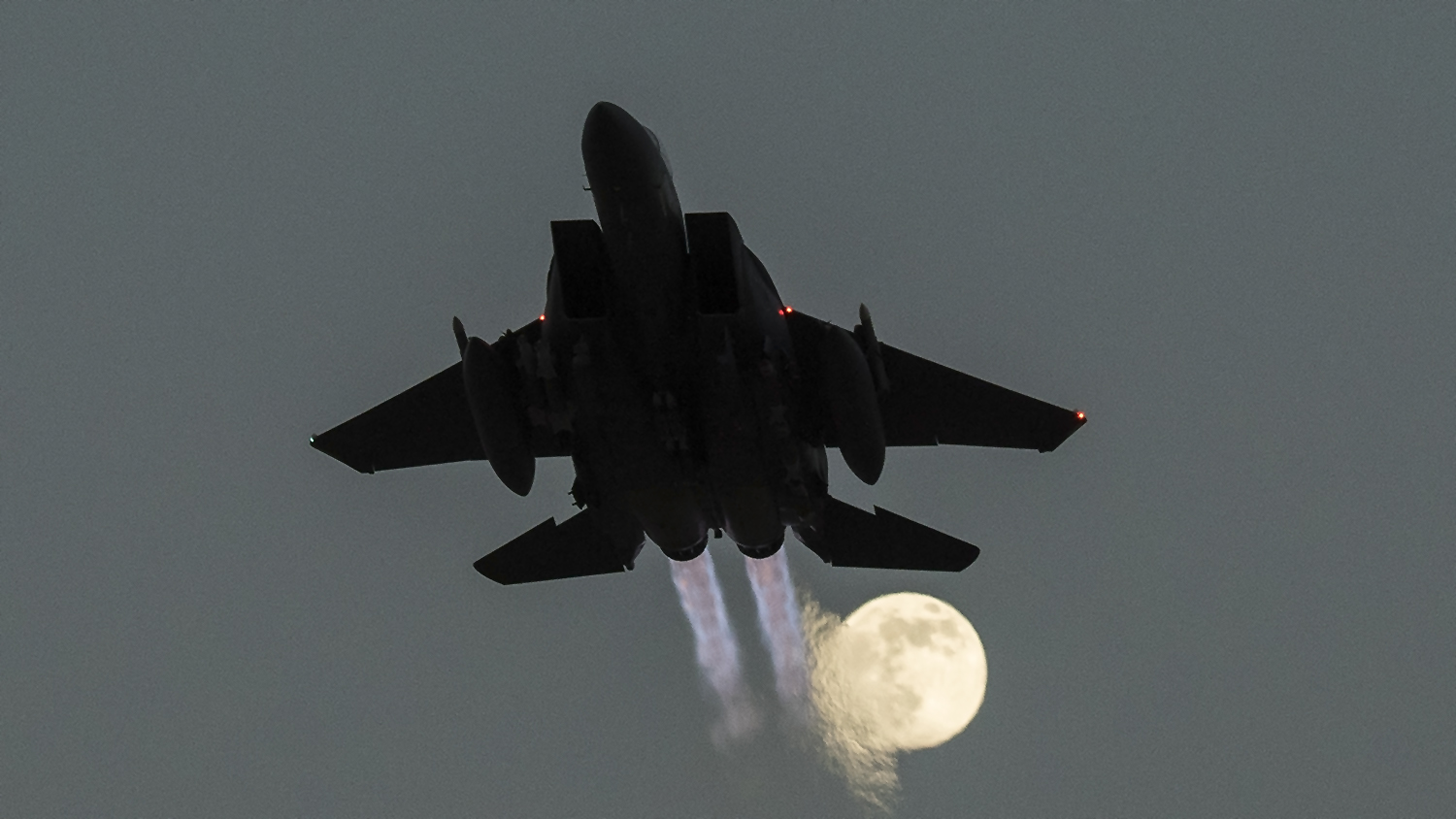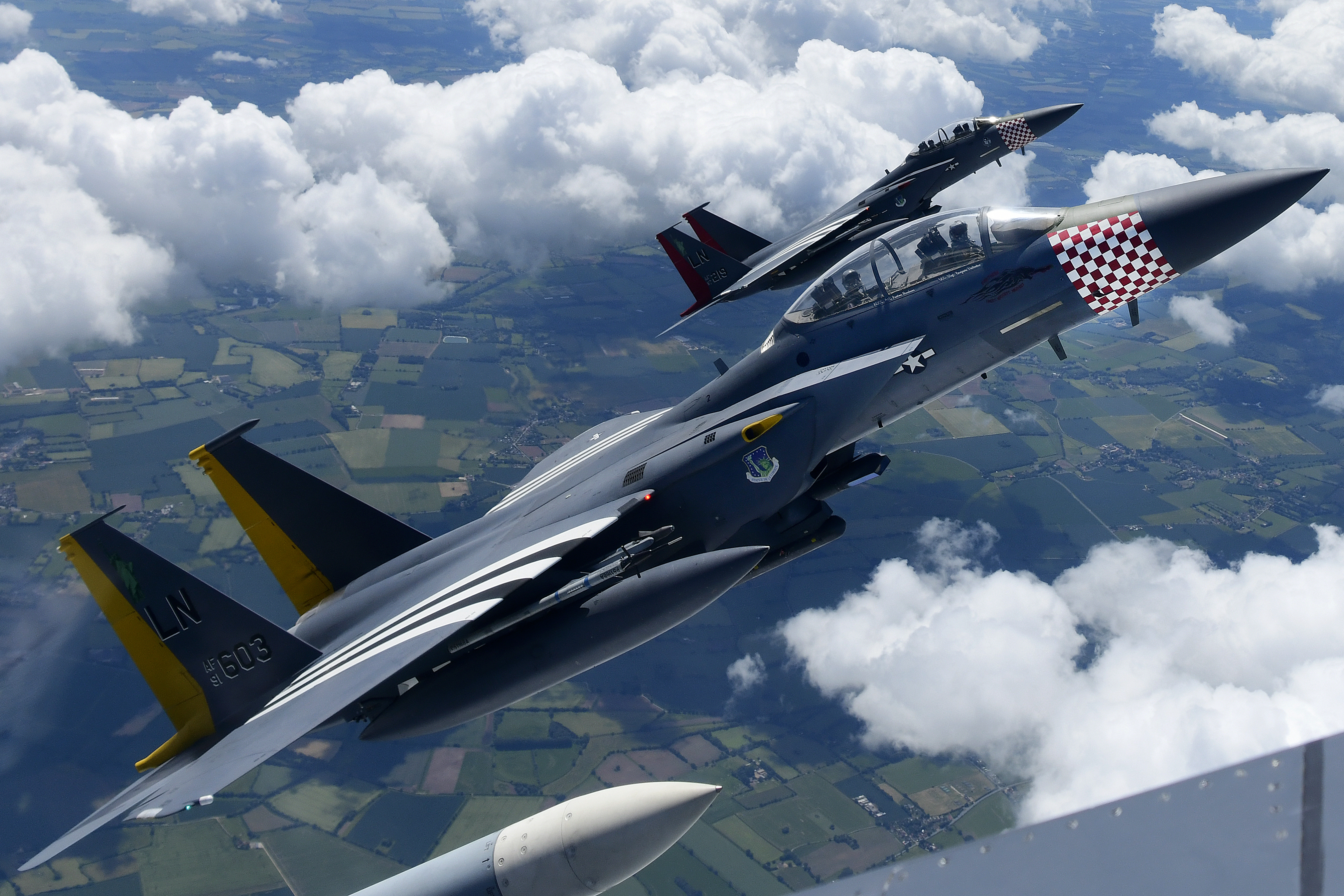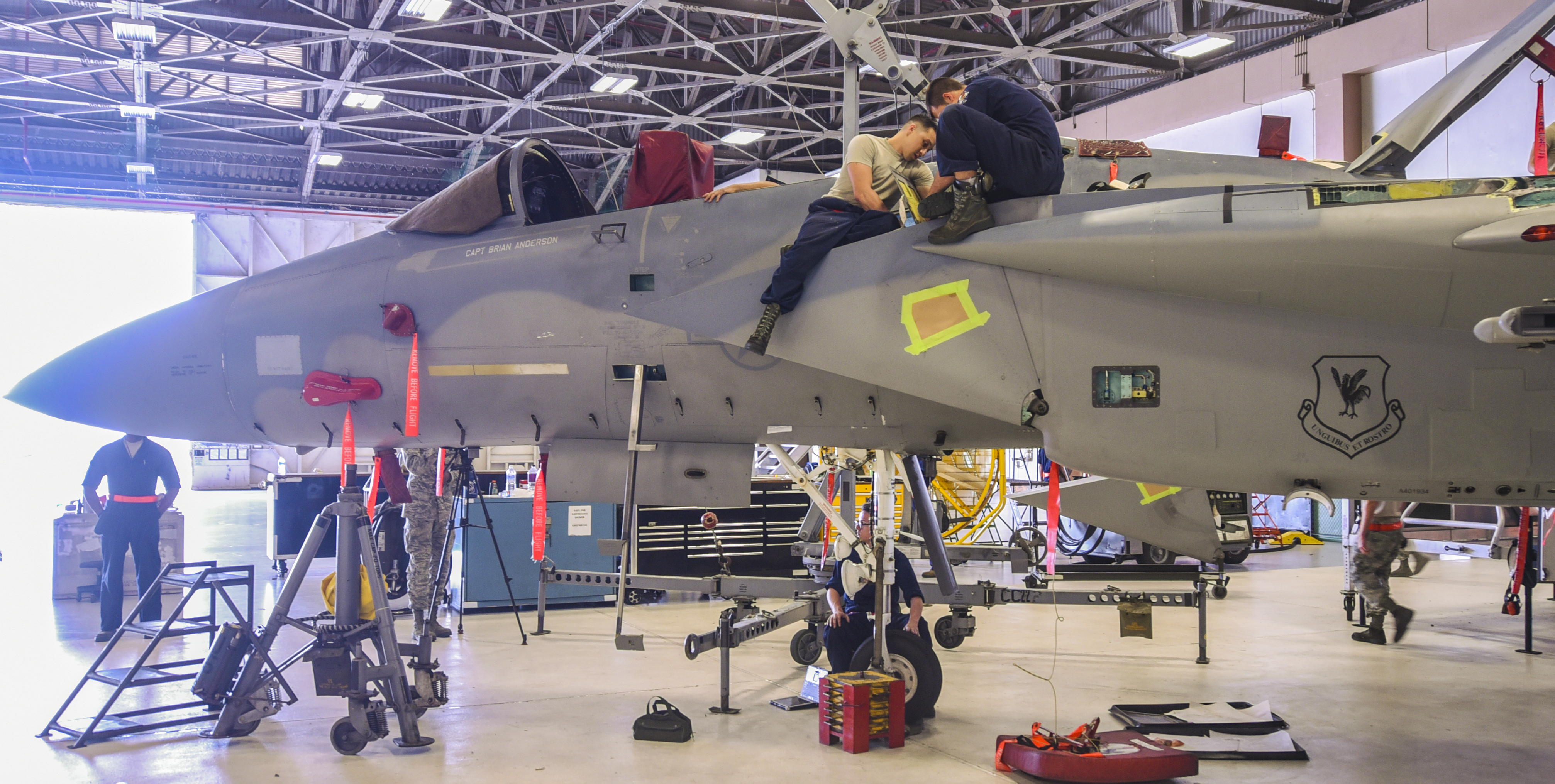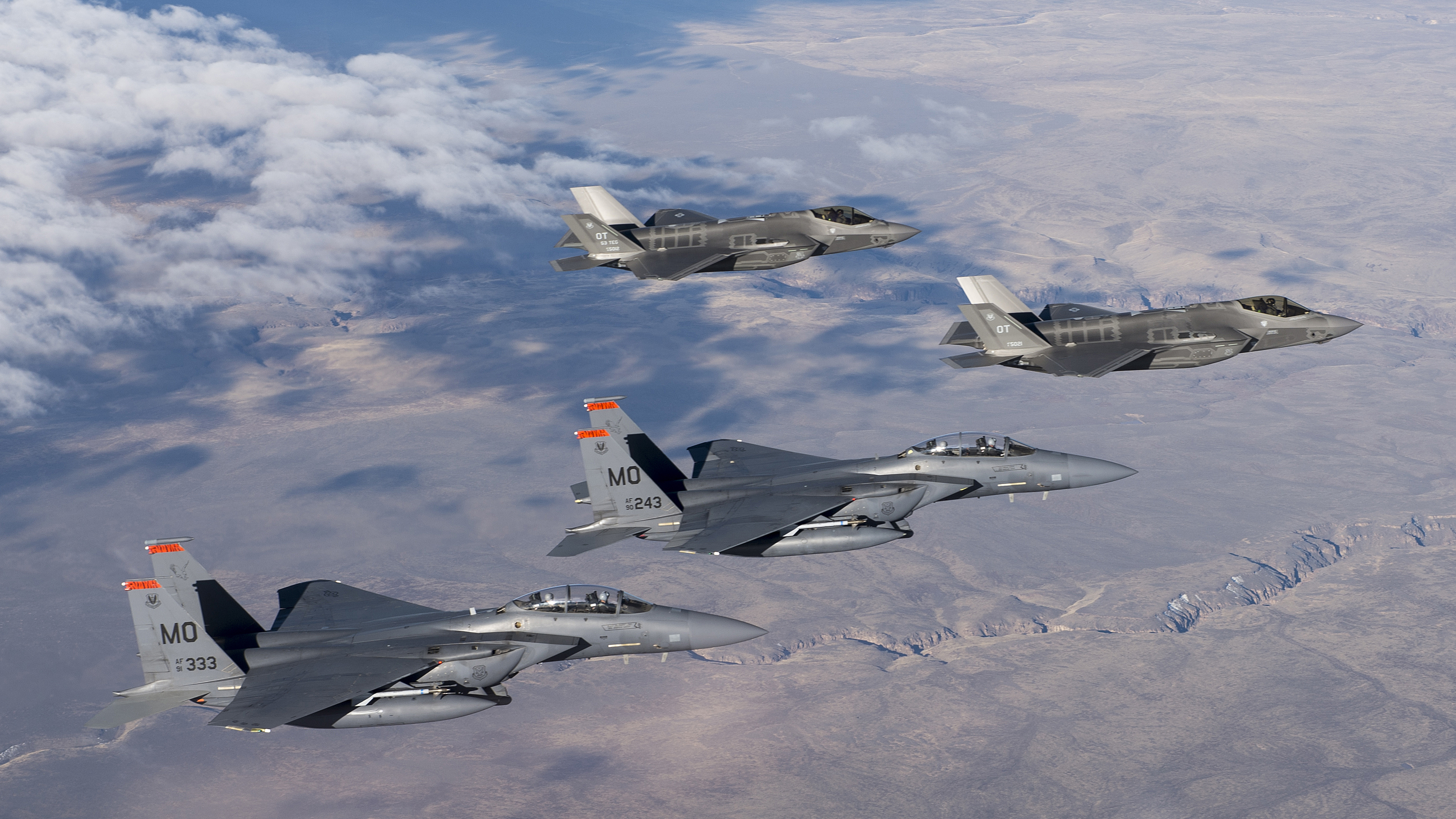The U.S. Air Force could expand its current F-15EX procurement plans in order to replace its F-15E Strike Eagles, according to official documentation. The service currently aims to recapitalize its aging F-15C/D air superiority fighters with the new F-15EX as a priority, but it has also left the door open to replacing its Strike Eagles with the type. Such an initiative wouldn’t come without controversy though, especially in terms of threatening the Air Force’s long-held, but often questioned F-35A procurement number goal of 1,763 airframes.
A Justification and Approval (J&A) document lays out the USAF’s case for buying the F-15EX. It says: “The objective of this program is to rapidly develop, integrate, and field the F-15EX weapon system to refresh/replace aging F-15C/D aircraft. A decision to also refresh F-15E aircraft has not yet been made, but remains an option.”
The report sets out the Air Force’s reasoning for the sole-source contract being awarded to Boeing for F-15EX, and it was signed off by USAF acquisition chief Dr. William Roper in August 2019. It carefully lays out the urgent plans to replace an F-15C fleet that it is running out of airframe hours. It adds: “The F-15 fleet is in dire need of a refresh, in particular the F-15C/D fleet, which without an expensive service life extension, will run out of airframe flying hours in [redacted}.” In keeping with major recapitalization projects, the timing would suggest that, when it comes, the need to replace the Strike Eagle will be just as urgent as it is currently for the F-15C/D.
You can check out the document for yourself here:
190818_FA8634-20-D-2704_F-15EX Development and Procurement_J+A_Redacted.pdfDownloadThe first production-standard F-15E Strike Eagle made its maiden flight on Dec. 11, 1986, from McDonnell Douglas’ St Louis, Missouri, plant. The first of 236 production Strike Eagles was handed over to the 461st Tactical Fighter Training Squadron “Deadly Jesters” on Apr. 12, 1988. The first operational unit — the 336th Tactical Fighter Squadron (TFS) “Rocketeers” —started to receive Strike Eagles at Seymour Johnson Air Force Base, North Carolina, in December 1988. The type was famously thrust into combat for Operation Desert Storm in 1991.

Strike Eagle serial 89-0487 from Seymour Johnson became the first example to reach 12,000 flight hours on August 16, 2016. The F-15E was beefed-up in comparison to the F-15C in order to carry a heavy weapons loads, however, like the Eagle, the youngest of which is 35 years old, the Strike Eagles are aging airframes.
The small 219-strong Strike Eagle fleet remains in high demand with an enduring commitment in the U.S. Central Command region that leverages many impressive niche capabilities. With just six front line Strike Eagle squadrons, at least one is always deployed. The F-15E is also capable of delivering nuclear weapons and is the first jet certified to employ the newest variant of the B61 tactical nuclear bomb.
The current F-15E fleet features two different engine classes. The oldest jets feature the Pratt & Whitney F100-PW-220E with roughly 23,500lbs of thrust. The younger models feature the P100-PW-229 engines with around 29,000lbs of thrust, making them the most capable of the lot by a serious margin. They are also the most numerous. The initial F-15EXs are set to receive the F110-GE-129 engine that also has 29,000lbs of thrust.

Buying more F-15EXs to replace the current F-15E would be hugely significant. USAF Chief of Staff Gen. David L. Goldfein has made regular assertions that the F-15EX will not impact the F-35 Lightning II program, but switching later F-35 procurement targeted at replacing the F-15E to the F-15EX could impact the overall F-35A projected inventory requirement. Moreover, the Boeing fighter has been used as a means to pile competitive pressure on Lockheed Martin to reduce F-35 procurement and through-life costs.
The J&A report underscores the reasoning behind purchasing the F-15EX in terms of ease of transition: “Refreshing the existing F-15 fleet (versus transitioning to a new advanced fighter aircraft) with F-15EX will dramatically reduce disruption to the logistics and sustainment infrastructure, as well as operational training and Mission Ready status of current F-15 units, by taking advantage of inherent familiarity with the existing aircraft, which will allow focus on the new and improved systems.”

The case for the urgent replacement of the F-15C/D includes reasons regarding safety. “The schedule impact if there is no refresh is exacerbated by the fact that the average age of the F-15C/D fleet is 35 years. The fleet’s structural integrity is rapidly degrading due to the high-g flight profile used during training and operations. One wing commander imposed a G restriction due to a loss of confidence in the safety of the fleet.”
The USAF examined a service life extension for the F-15C, but this was ruled out as not being cost-effective. The speed with which Boeing can build the F-15EX is cited as another key differentiator. Based on the foreign investment in the Saudi Arabian F-15SA and Qatari F-15QA projects, the USAF’s F-15EX will share “90-95 percent commonality” with the Qatari jets, but it will receive some USAF-specific additions such as Eagle Passive/Active Warning and Survivability System (EPAWSS).

The report adds that buying the F-15EX “will save the USAF $3 billion over the Future Years Defense Program compared to replacing that fleet with F-35s by avoiding significant transition costs required for a new aircraft.” It adds: “The USAF estimates that it will take six months or less to transition from the F-15C/D to the F-15EX given the significant commonality between the F-15C/D and F-15EX aircraft components and ground support equipment, while the transition time from F-15s to the F-35 (or any other airframe) will take approximately 18 months for an Active Duty squadron and 36 months for an Air National Guard squadron. Accordingly, from both an economic and readiness perspective, no other aircraft will satisfy the USAF requirement to refresh the F-15C/D fleet.”
In addition, the document makes it clear that the premium once placed on an all stealth tactical fighter fleet has eroded: “The USAF has determined that a mix of 4th generation capacity and 5th generation capability is necessary in balancing near and mid-term readiness with future needs.”
These were all reasons we discussed as per the justification for the ‘F-15X’ when The War Zone broke the story of its existence two years ago.

There are no official plans to replace the F-15E when it is retired from service, and officially it could remain in service through life-extension programs. Yet, based on the situation facing the F-15C/D, it could be up for replacement as early as the end of the decade. Previously, the War Zone was told that the F-15EX “is intended to directly replace the USAF’s entire F-15C/D fleet. It would have no impact on the existing F-15E Strike Eagle fleet or its planned upgrade pathway that is underway now.”
The F-15E shares similar cutting-edge technology as is being fielded in the F-15EX. It has been upgraded with the Raytheon AN/APG-82(V)1 Active Electronically Scanned Array (AESA) radar, the new Advanced Display Core Processor (ADCP) II, and it too is receiving the new EPAWSS self-protection system.
The current F-15EX procurement plan as set out earlier this month could be worth up to $22.9 billion over 10 years. This cost ceiling is based on a March 2019 F-15 SPO Rough Order of Magnitude (ROM) estimate for the maximum quantity of 200 aircraft. However, the report says procurement quantities will be established at a Most Probably Quantity (MPQ) of 144 aircraft. Still, this is seen as the minimum fleet size and it is likely to reach near or at the 200 level just in regards to replacing the F-15C/D fully.

The current F-15C/D fleet of approximately 245 aircraft would be replaced on what would be close to a one-for-one basis if all options are exercised. While the report doesn’t discuss actual numbers, it would suggest the similarly sized F-15E fleet could be recapitalized under a very similar model, which would take F-15EX procurement out to roughly 400 aircraft.
A USAF spokesman told Air Force Magazine “That decision has not been made,” regarding the F-15E. A common F-15EX fleet in a merged Eagle community would have its benefits both logistically and operationally. There is also bound to be some tension between the F-15C/D units, the vast majority of which are Air National Guard, and the active-duty F-15E community under the current procurement plan for the F-15EX.
As the plan sits, the F-15EX would equip squadrons whose only missions have been air-to-air combat and air sovereignty with the most advanced and reliable multi-role F-15s in the entire force. In other words, the F-15E community, which is tasked with some of the most complex combat operations abroad, would be flying aging, partially upgraded jets while the Guard has brand new F-15EX with excess capabilities. This has raised the question of why doesn’t the F-15E get replaced with the F-15EX and the current F-15C/D community receive surplus F-15Es?

With over 50 years of production, the F-15 is entering into uncharted territory for fighter aircraft manufacturing. Boeing has cleverly retained credibility through reinventing the F-15 via foreign investment. With at least 144 new F-15s entering the Air Force’s fleet in the near term, some 16 years after its last new Eagle was delivered, the prospects for follow-on orders are certainly there. This doesn’t mean that recapitalizing the Strike Eagle fleet with F-15EX is anywhere near a done deal, but the door is open and it might just prove to be another case of the swiftest, cheapest, and most sensible way to keep some of the Air Force’s most important fighter squadrons in business.
Regardless, with the F-15EX’s stated service life of a whopping 20,000 hours, the Eagle will be gracing American fighter wing ramps well into the second half the century.
Contact the editor: Tyler@thedrive.com
